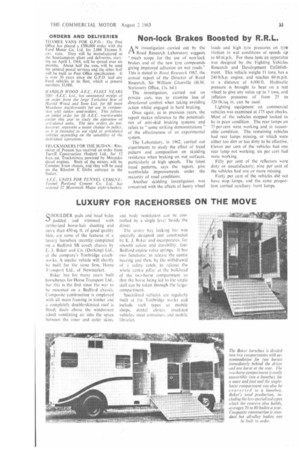Non-lock Brakes Boosted by R.R.L.
Page 35

If you've noticed an error in this article please click here to report it so we can fix it.
N investigation carried out by the I—I Road Research Laboratory suggests " much scope for the use of non-lock brakes and of the new tyre compounds giving improved adhesion on wet roads." This is stated in Road Research 1962. the annual report of the Director of Road Research, Sir William Glanville (H.M. Stationery Office, I Is. 6d.).
The investigation, carried out on private ears, was to examine loss of directional control when taking -avoiding action whilst engaged in hard braking.
Once again, as in previous years. the report makes reference to the potentialities of anti-skid braking systems and refers to some striking demonstrations" of the effectiveness of an experimental system.
The Laboratory, in 1962, carried out experiments to study the effect of tread pattern and composition on skidding resistance when braking on wet surfaces, particularly at high speeds. The latest tread patterns, says the report, give worthwhile improvements under the majority of road conditions. Another skidding investigation was concerned with the effects of heavy wheel loads and high tyre pressures on tyre friction in wet conditions at speeds up to 60 m.p.h. For these tests an apparatus was designed by the Fighting Vehicles Research and Development Establishment. This vehicle weighs 11 tons, has a 240 b.h.p. engine, and reaches 60 m.p.h. in a distance of 4,000 ft. Hydraulic pressure is brought to bear on a test wheel to give any value up to 5 tons, and inflation pressures of from 25 to 320 lb./sq. in. can be used.
Lighting equipment on commercial vehicles was examined at 175 spot checks. Most of the vehicles stopped looked to be in poor condition. The rear lamps on 75 per cent were working and in reasonable condition. The remaining vehicles had rear lamps missing, or which were either too dim or too dirty to be effective. Eleven per cent of the vehicles had one rear lamp not working; six per cent had none working.
Fifty per cent of the reflectors were dirty or unsatisfactory; nine per cent of the vehicles had one or more missing.
Forty per cent of the vehicles did not have stop lamps, and the same proportion carried auxiliary front lamps.




























































































